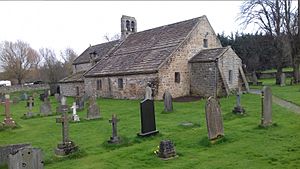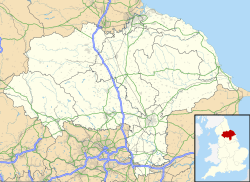Church of St Andrew, Finghall facts for kids
Quick facts for kids St Andrew's Church, Finghall |
|
|---|---|
| The Parish Church of St Andrew, Finghall | |

The Church of St Andrew, Finghall
|
|
| 54°18′24.2″N 1°42′30.5″W / 54.306722°N 1.708472°W | |
| OS grid reference | SE182897 |
| Location | Finghall |
| Country | England |
| Denomination | Church of England |
| Weekly attendance | 15 (average between 2006–2015) |
| History | |
| Status | Active |
| Dedication | St Andrew |
| Architecture | |
| Architectural type | Early English |
| Specifications | |
| Bells | 2 |
| Administration | |
| Parish | Finghall |
| Deanery | Wensley |
| Archdeaconry | Richmond and Craven |
| Diocese | Leeds |
The Parish Church of St Andrew, Finghall, is a historic church located near the village of Finghall in North Yorkshire, England. It's a very old building, standing where an even older Anglo-Saxon church once was. Some parts of the current church are from the 12th century!
This church is actually closer to a small place called Akebar than to Finghall village itself. This is because the original village where the church stood was abandoned long ago. People moved away after a terrible sickness, like the plague, hit the area. Today, St Andrew's Church is a special building listed as grade II* listed, meaning it's very important historically. People still use it for church services.
Contents
History of St Andrew's Church
St Andrew's Church in Finghall was built in the late 1100s. It was made in a style called Early English. The church has a tower at the west end. It also has a main hall (nave) and a special area near the altar (chancel). A rare double bell holder, called a bell-cot, sits on the church roof.
Ancient Parts and Changes
The church roof is quite low, almost reaching the ground. One of its two bells is very old, from 1620. Some parts of the church are even older, from the Anglo-Saxon period. For example, there's a doorway that was blocked up around 1140. You can also see a piece of an Anglo-Saxon cross-head from the 800s built into the chancel.
The church was rebuilt in the 1300s. Smaller changes were made in the 1700s and 1800s. A big restoration happened in 1904. More work was done in 1959 and 1964 to keep it in good shape.
The most recent restoration was in 2000. During this time, special boards with the Ten Commandments were fixed. These boards were first introduced by Queen Elizabeth I in the 1500s. Finghall church got its boards in the mid-1700s.
Music and Location
In 1801, the church had musicians and singers. Later, in 1865, a harmonium was used instead. This was replaced in 1894 by a larger organ. This organ had previously been used at Constable Burton Hall.
The church is next to Leeming Beck, a stream. It was once part of an Anglo-Saxon village. People believed the plague spread through water. So, the villagers moved about 0.5 miles (1 km) south to the current site of Finghall village. Because of this, some historians call places like St Andrew's 'Plague Churches'.
Important Families and Airmen's Graves
Important families like the Fitzhugh and Wyvill families supported the church. They had the right to choose the church's leader, known as advowson. The Scrope family lost this right in 1415. Their lands, including Finghall church, were taken by the King. This happened because Henry Scrope was involved in a plot to harm King Henry V. Scrope was executed for this.
In the churchyard, there are two graves of military airmen. One is for E.H.G. Sharples, a Royal Flying Corps airman. He was the son of the vicar of Finghall and died in a training accident in 1918. The other grave is for Flying Officer N.J.M. Barry, who died during the Second World War.
The Lower Wensleydale Group
St Andrew's Church is part of a group of six churches. These churches work together and are known as Lower Wensleydale. The other churches are St Gregory's in Crakehall, St Mary's in Hornby, St Michael's in Spennithorne, St Oswald's in Hauxwell, and St Patrick's in Patrick Brompton.
Vicars at Finghall
Below is a list of rectors of Finghall. At some point in the late twentieth century the incumbent at Patrick Brompton became the vicar for the extended parish.
- John de Segbrook - 1368
- Will Lyllforth
- Will Foxholes - 1420
- Roger Parker - 1457
- John Taylor
- Peter Conder
- William Typping - 1541
- Lacell Routh - 1572
- Reginald Lancaster - 1587
- Matthew Levett - 1622
- Henry Paget
- Robert Smith - 1665
- Henry Raper - 1710
- Thomas Nelson - 1735
- Luke Yarker - 1776
- Nicholas Bourne - 1803
- Edward Wyvill - 1820
- George Henry Ray - 1869
- Henry Milner Sharples - 1893
- Walter Hawkesworth Fawkes - 1920 (held in plurality with the parish of East Hauxwell)
- John William de la Poer Beresford-Peirse - 1944
- Dominic Thomas Reynolds Carlin - 1947
- Joseph Nicholls Jory - 1954
- Benjamin William Crawford - 1971
- William Frederick Greatham - 1975
- Raymond Joseph Pearson - 1982
- David James Christie - 1995
- William John Hulse - 2002
- Bryan Stanley Dixon - 2012 (Held in plurality with the parishes of Patrick Brompton, Hornby & Crakehall)
- Robin David Christopher Lawton - 2017
See also
- Grade II* listed buildings in North Yorkshire
- Listed buildings in Finghall


